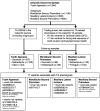Rare and Common Variants Conferring Risk of Tooth Agenesis
- PMID: 29364747
- PMCID: PMC5958369
- DOI: 10.1177/0022034517750109
Rare and Common Variants Conferring Risk of Tooth Agenesis
Abstract
We present association results from a large genome-wide association study of tooth agenesis (TA) as well as selective TA, including 1,944 subjects with congenitally missing teeth, excluding third molars, and 338,554 controls, all of European ancestry. We also tested the association of previously identified risk variants, for timing of tooth eruption and orofacial clefts, with TA. We report associations between TA and 9 novel risk variants. Five of these variants associate with selective TA, including a variant conferring risk of orofacial clefts. These results contribute to a deeper understanding of the genetic architecture of tooth development and disease. The few variants previously associated with TA were uncovered through candidate gene studies guided by mouse knockouts. Knowing the etiology and clinical features of TA is important for planning oral rehabilitation that often involves an interdisciplinary approach.
Keywords: genetics; hypodontia; molecular genetics; odontogenesis; oligodontia; orofacial cleft(s).
Conflict of interest statement
The authors declare no potential conflicts of interest with respect to the authorship and/or publication of this article.
Figures



References
-
- Alves-Ferreira M, Pinho T, Sousa A, Sequeiros J, Lemos C, Alonso I. 2014. Identification of genetic risk factors for maxillary lateral incisor agenesis. J Dent Res. 93(5):452–458. - PubMed
-
- Bulik-Sullivan BK, Loh PR, Finucane HK, Ripke S, Yang J, Schizophrenia Working Group of the Psychiatric Genomics Consortium, Patterson N, Daly MJ, Price AL, Neale BM. 2015. LD Score regression distinguishes confounding from polygenicity in genome-wide association studies. Nat Genet. 47(3):291–295. - PMC - PubMed
-
- Carter K, Worthington S. 2015. Morphologic and demographic predictors of third molar agenesis: a systematic review and meta-analysis. J Dent Res. 94(7):886–894. - PubMed
Publication types
MeSH terms
Grants and funding
LinkOut - more resources
Full Text Sources
Other Literature Sources

